Surgical Report
Contemporary concepts in lymphatic surgery A little old and a whole lot new By James Kennedy
A
s readers of this magazine will already know, decades of research attest to the successful management and stabilization of lymphedema through nonsurgical means such as decongestive therapy, compression garments, manual lymphatic drainage, and rigorous skin care. Conversely, surgical treatment for lymphedema was historically quite limited and often reserved for the most severe and selected cases. The failure to develop novel surgical procedures seemed to result from a primitive understanding of lymphedema progression and only basic anatomical knowledge of the microcirculation.
Surgical management for lymphedema is still in its infancy and comprehensively relies on a coordinated interplay with conservative therapy. Advances in real-time imaging of the lymphatic system and evolution of extremely fine surgical instruments has led to enhanced interest in surgical options for lymphedema. Surgical awareness has been reinforced through a greater exposure of lymphedema in the public eye and due to patient demand for a potential surgical choice. Despite this,
surgical management for lymphedema is still in its infancy and comprehensively relies on a coordinated interplay with conservative therapy. A variety of surgical options have been proposed for lymphedema in the past. Some of these older techniques have limited application today but are still mentioned here for historical context. Surgical management for lymphedema can be classified into three categories based on mechanism of action. These include: 1) preventative methods; 2) excisional techniques, 3) physiological procedures, and 4) combined modalities. This article will briefly discuss each category and the various options within them.
Dr. James Kennedy MD, PhD, FRCSC, ABPS is a Plastic and Reconstructive surgeon and site chief at the South Health Campus hospital in Calgary, Alberta. He is a faculty member in the Cumming School of Medicine at the University of Calgary. His practice predominantly focuses on breast reconstruction, microsurgery, trauma, hand surgery, gender transformation, and lymphatic reconstruction.
Wi n t e r 2 0 2 0
1 Preventative methods Preventative opportunities are often considered in secondary forms of lymphedema that may develop in an iatrogenic fashion after lymph node dissection or in response to another ancillary procedure. The various strategies either try to provide a guide towards a more detailed and refined dissection of lymphatic basins in cancer surgery, intraoperatively identify susceptible lymphatic channels and preserve them, and/or reconstruct damaged lymphatic channels at the time of potential injury. All are designed to prevent or limit the development of lymphedema at the time of or near the inciting event. Sentinel Lymph Node Biopsy is a form of lymph node dissection in oncologic surgery that is based on removing or sampling lymph nodes that are the first order drainage of the affected region (e.g. breast) that may have cancer present. By “sampling� the first or second Ly m p h e d e m a p a t h w a y s . c a 5




